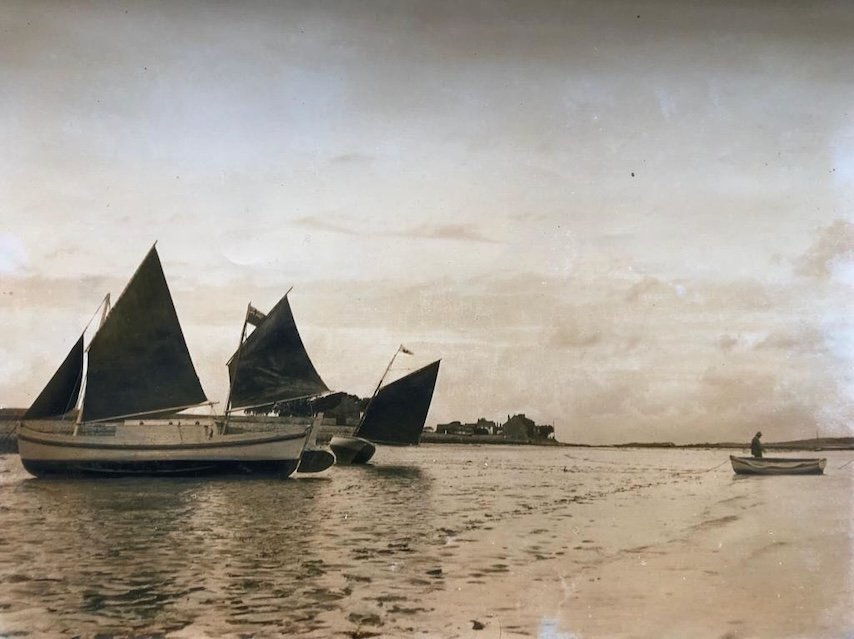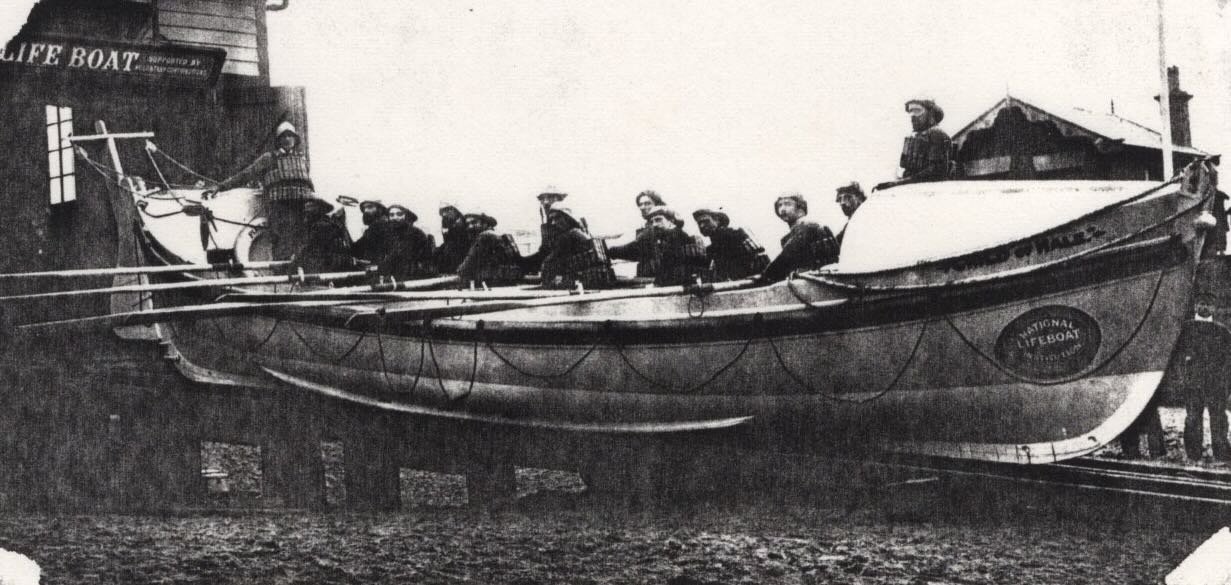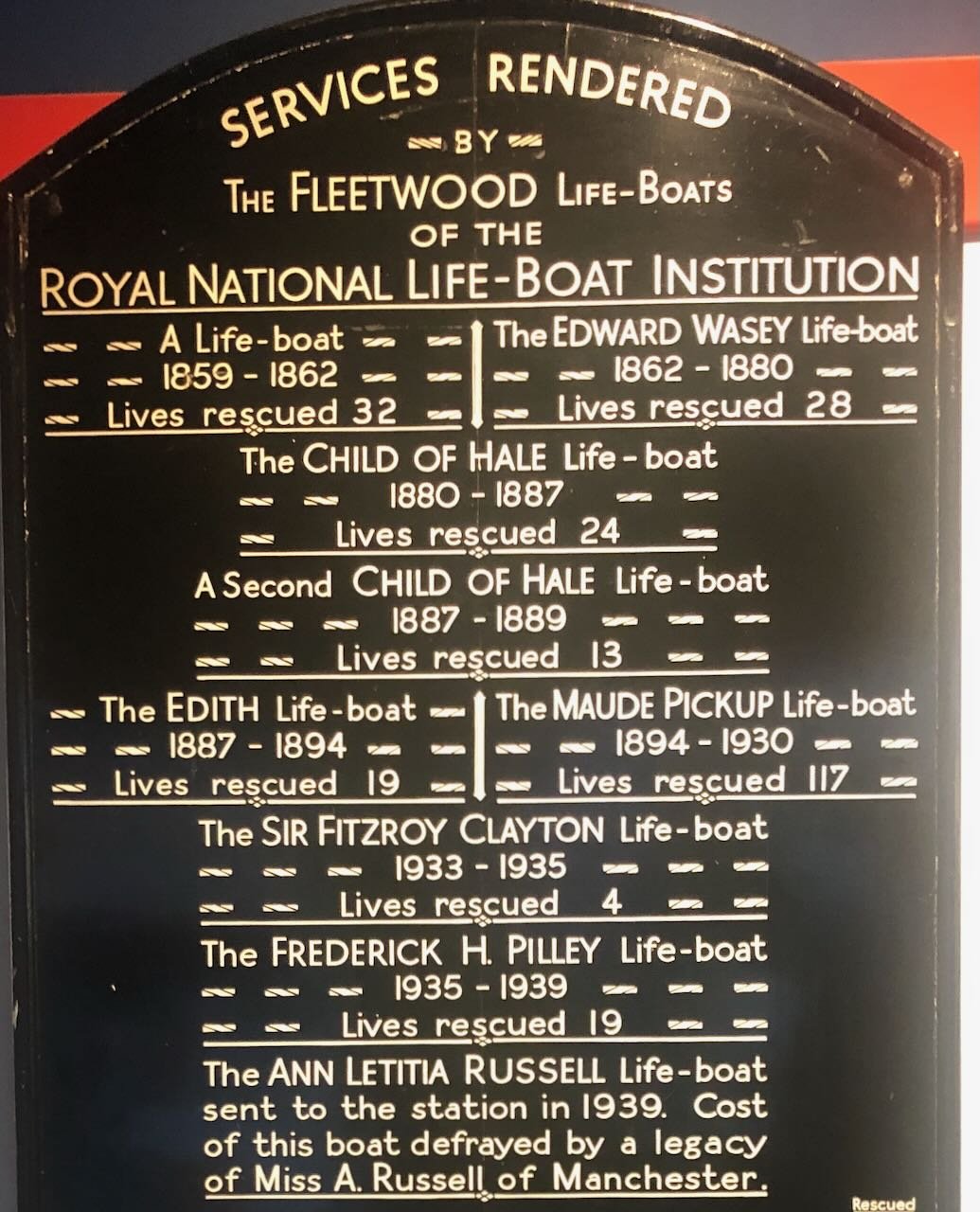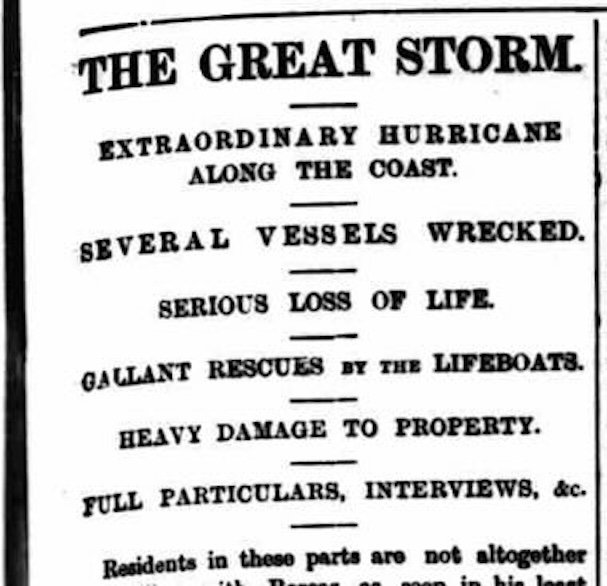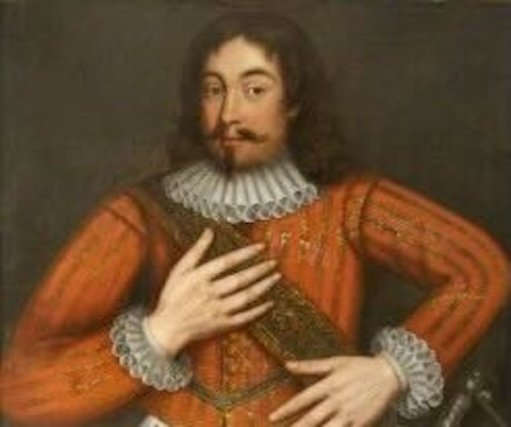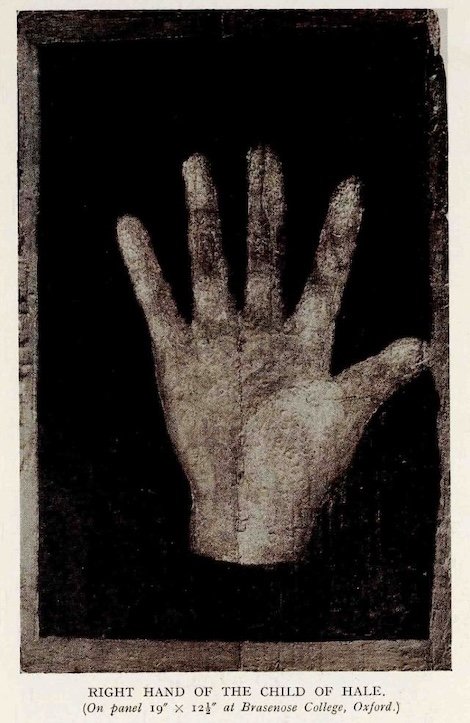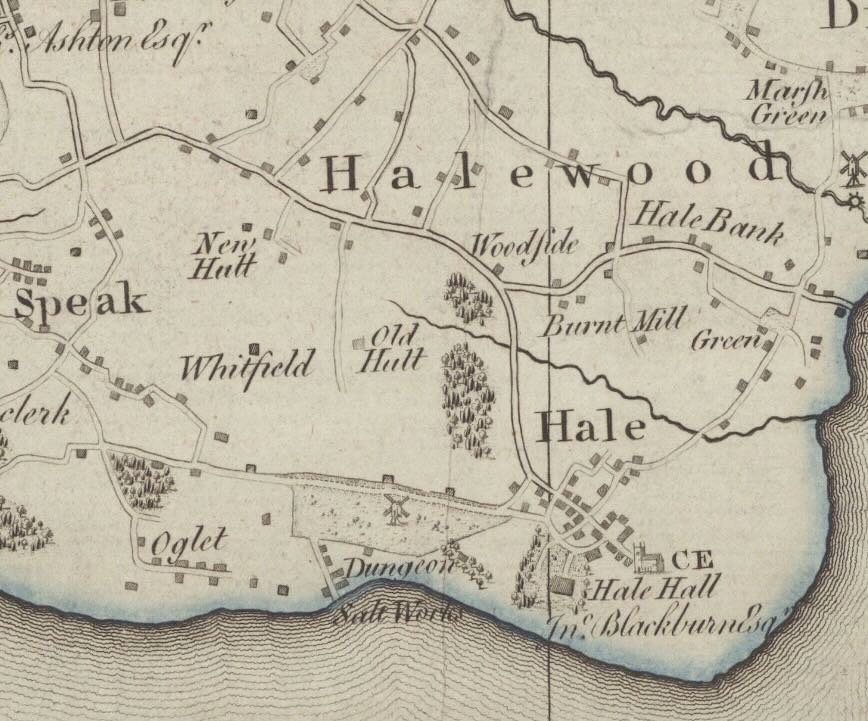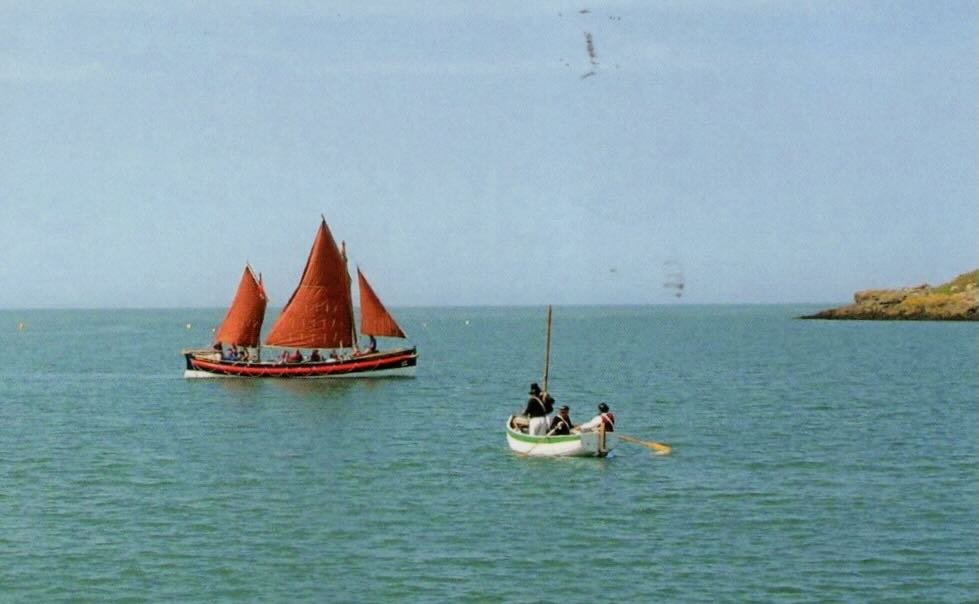‘Child of Hale’
A Heroic Rescue at Fleetwood
A 9ft 3inch Giant
The Full Particulars etc.
The crew of Fleetwood Lifeboat ‘Child of Hale’, which served from 1887 -1892: Photo from the collection of Wilton Atkinson.
This is a story of heroic courage from another famous lifeboat - and crews - with a direct link to Sunderland Point. As well as many lives saved, the boat was involved in an astonishing rescue during the great storm of 1890.
(The other famous SP lifeboat was Peggy who as Chapman saved many lives, for the full story click here)
Less breath-taking but still interesting is the explanation of the boat’s unusual name.
From a correspondent
Shortly after publishing the John Walker photographs last October an email pinged in suggesting one of the images might be of the Child of Hale. It was a boat not an infant. Here is the rather fuzzy original photograph taken by John from the front door of number 7.
Child of Hale A John Walker photograph c1905: Courtesy Lancaster City Museums.
The unusual name rang a distant bell. There is comment about the boat in ‘A Forgotten Lancashire Port’, the lecture notes about Sunderland Point assembled by Anne G. Gilchrist in the years around 1908.
Anne is writing of survivors ‘here is a modern one, a retired lifeboat, the "Child of Hale", which after an honourable career in lifesaving off the Lancashire coast "carted stones for many a year’. It was bought for an old song, and is now, in its serene old age, used as a picnic and bathing-boat, and still sails like a duck.’
Child of Hale: Courtesy of the Gilchrist family.
The boat was owned by Anne’s brother George (the younger) who with other members of the family were regular summer visitors. Nothing has been found about ‘carting stones’ but looking through extra information, its service as a lifeboat leaps from the pages.
This small boat used at the Point as a pleasure craft, for bathing and picnics, has a serious history.
A Fleetwood Lifeboat
As well as the opening photograph there are two others in Wilton’s album.
The Child of Hale on the slipway at Fleetwood: From the collection of Wilton Atkinson.
And a copy of this handwritten list.
A list of the assistance and rescues of the Child of Hale lifeboats compiled by Maggie Boote nee Swainson: From the collection of Wilton Atkinson.
Zara Robinson, collections assistant at the Fleetwood Museum was quick to respond to a request for help. She told us.
“In fact, there were two famous lifeboats carrying the name of the Child of Hale, the first in service from 1879 to 1887 and the second from 1887 to 1892.”
“Both boats were provided from a generous gift of £900 from a Colonel William Blackburne, who was a resident (at that time) of Leamington Spa - but was a native of Lancashire. The balance of his money was also used to construct a new Lifeboat House and slipway built upon piles on the beach.”
“The boats were very well known in the town; they made regular appearances in the newspapers”.
Zara sent this photo of the old ‘honours board’ of the RNLI.
Top half of the RNLI ‘honours board: Courtesy Fleetwood Museum. (The date the second boat was decommissioned is incorrect, it should read 1892.)
The archive of British Newspapers contains back issues of ‘The Fleetwood Chronical’. Zara was right, it was clear from the many entries the Child of Hale and crew were celebrated, even training exercises attracted townspeople to turn out and cheer the lifeboat volunteers.
The first mentioned rescue on the handwritten list was soon found. In 1882 the Venus of Sweden a Norwegian vessel carrying timber bound for Fleetwood, had run aground on a sandbank in dangerous waters. A first attempt by the crew of the Child of Hale rescued the captain, his wife, their baby, and a servant girl and in a second attempt rescued the eight-remaining crew.
Turning the e-pages, through the editions, we came to the rescue in the early morning of the 7th of November 1890
The Great Storm
The Fleetwood Chronical November 7th, 1890: Courtesy of JPI Media
The storm raged overnight on the 6th/7th of November. The winds reached hurricain force, wreaking havoc along the south Lancashire Coast with tragic loss of life, destoying homes and causing extensive flooding.
This extract from the paper was written as the storm was abaiting on the morning of the 7th. The unnamed writer - a witness from the shore - quickly collected first hand interviews and hurriedly wrote up the story.
The words are as vivid as the rescue.
The barque (three masted ship) Labora was in distress and rockets were being sent up. Mr. Wright (coxwain) proceeded to the lifeboat house where the signal gun was fired six times for the crew to assemble. 15 men arrived, notwithstanding the terrible nature of the weather the small boat ‘Child of Hale’ was launched at about 6am and taken in tow by a tugboat proceeded out to sea.
The blinding sleet and foam combined with the darkness of the morning rendered the work of the brave lifeboat men all the more difficult. The lights shone of the barque guided the rescuers to where she was stranded, the arduous and perilous journey being accomplished in about an hour's time.
On arriving near the vessel on the windward side, the tug left the lifeboat to drift down to the barque. The anchor of the Child of Hale was let go about 100 yards from the Labora and commenced one of the most difficult tasks it has fallen to the lot of the Fleetwood lifeboat. The boat and crew being almost underwater with broken waves the whole of the time and the blinding spray rendering it almost impossible for the men to see what was going on around them.
After many futile attempts a line was at last got aboard the barque and a hawser with a life buoy attached was put over to the vessel. After great deal of manoeuvring the rescuers managed to fasten their boat about 20 yards from the barque. Fully an hour was occupied in transferring the shipwreck crew of 13 men to the lifeboat, the work was fraught with greatest peril, the sea was running mountains high and the spray dashing in huge showers over the vessel. The mate of the Labora had received an injury which had rendered him lame while the steward was ill and in a most pitiable condition.
Each sailor tied rope about him and then threw himself into the seething mass of water through which he was dragged on board the lifeboat. All the seamen were finally safely landed on board the lifeboat the captain being the last to leave his ship. The men were completely worn out having been on deck all night without food. Coxswain Wright states that
this was the roughest experience he has ever had and never remembered the sea running so high and dangerous.
At about 10am the rescuers and the rescued arrived at the ferry slip (at Fleetwood) where they were received with ringing cheers by a large concourse of people who had assembled notwithstanding the drenching rain and high wind.
For their gallantry each crew member received £10 each from the Norwegian government (the Labora sailed under the flag of Norway) and were treated to ‘a great feed’.
The coxswain Robert Wright was awarded the Royal National lifeboat institution's silver medal.
Here it is in the original case, it’s on display at the museum.
RNLI silver medal awarded to Robert Wright coxswain of the Child of Hale: Courtesy Fleetwood Museum
The Child of Hale - what about the unusual name?
The meaning is a person from a place called Hale, a very special person it turns out.
The top half of a legendary giant: Courtesy National Trust Collections
In a village near Liverpool there once lived a giant who was 9ft 3in tall. He grew to this height in a single night, he was so tall and his cottage so small, when he went to bed his feet hung out the window.
This is the legend of John Middleton a farmer born in Hale in 1578 who was very tall and of considerable strength. He died in 1623 and is buried in Hale churchyard. When the body was moved to a new grave the bones were measured confirming a remarkable size.
In 1617 Sir Gilbert Ireland of the local gentry and sheriff of Lancashire recognising an interesting curiosity took John to London and the court of James I hoping to enlist John as a royal bodyguard. A wrestling match was arranged with the Kings champion, unfortunately, in winning John dislocated the thumb of his opponent. Many in the court lost bets and John was given £20 and pointed to the way home.
On the journey home, as well being robbed of the £20, they paused at Brasenose College, in Oxford whilst these drawings were made of John’s hands.
Courtesy Brasenose college Oxford
Courtesy Brasenose college Oxford
From measurements of these hands the Guinness Book of Records reports his height as 7ft 6inches. To this day the name of the boat rowed by college first VIII is named the Child of Hale
Remember the boats were the generous gift of a Colonel William Blackburne - the Blackburnes owned considerable property around Hale and had become very wealthy from salt deposits on their land and the transatlantic trade from Liverpool.
A section from William Yates’ map of 1786 showing the Dungeon Salt Works. Hale Hall and most of Hale belonging to John Blackburn Esq: Map Courtesy National Library of Scotland
There is more. Hale Hall was originally the home of the Ireland family, direct relatives of Gilbert Ireland who took John Middleton to London. In 1752 Thomas Blackburne married the heiress of the Ireland family and Hale Hall became the residence of the joined families.
Perhaps it was a stipulation of his gift that the Colonel desired the lifeboats to be named after his local legendary giant.
What happened to the boat?
As best we know the boat was sold after George Gilchrist died in 1918. But that’s not quite the end of the story. In Wilton’s album of photographs connected with the Child of Hale is one last image. There is no explanation and only ‘Cemaes Bay’ is printed on the back. It suggested the Child of Hale was restored and used as a pleasure boat in the waters off North Anglesey. We hope so.
Child of Hale? From the collection of Wilton Atkinson
Thanks to Zara Robinson of the Fleetwood Museum for photographs, information, and advice, and to the Gilchrist family for information and photograph.
Lastly, before we close, here is the full-length image of the ‘Child of Hale’ in all his tallness.
Courtesy National Trust Collections


